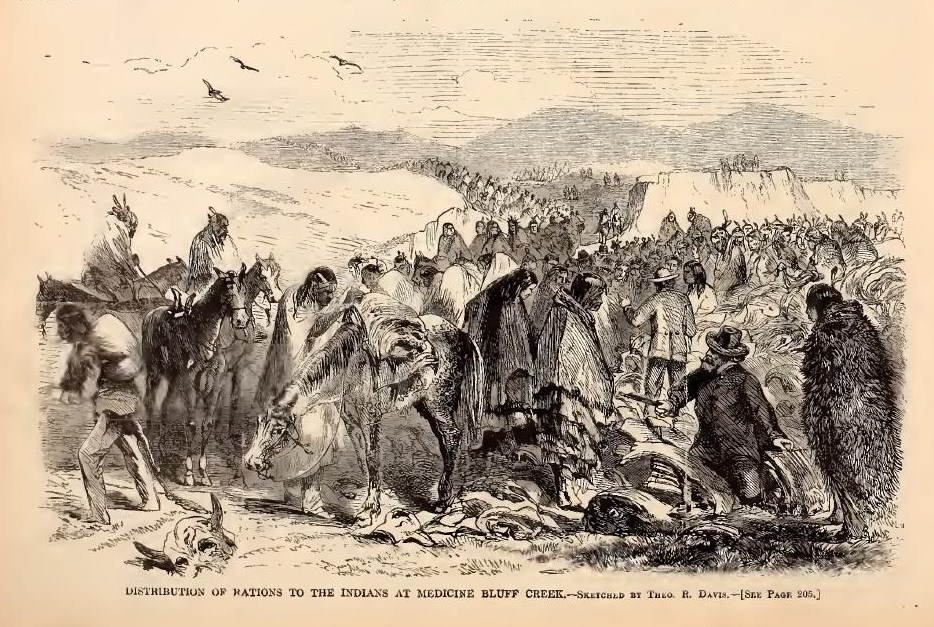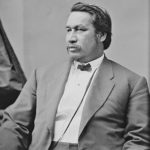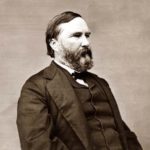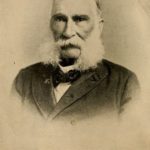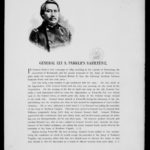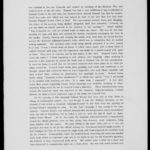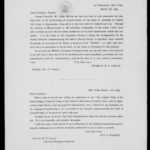You could say it’s a (very brief) tale of five Union generals. When Ulysses S. Grant became President of the United States in March 1869 he promoted his friend William T. Sherman to be the Commanding General of the U.S. Army. Phil Sheridan replaced Sherman as head of the Military Division of the Missouri. I’m not sure if an army man would consider this a promotion or not, but John Schofield, who served as Andrew Johnson’s last Secretary of War, was told to go west and take General Sheridan’s place as head of the Department of Missouri. And, according to the March 27, 1868 issue of Harper’s Weekly, General George Custer was still out west pursuing hostile natives:
ISSUING BEEF TO THE INDIANS
AT MEDICINE BLUFF CREEK.
Our correspondent writes from Medicine Bluff Creek, where the different bands of Comanche, Kiowa, Apache, and Arrapahoe Indians are assembled, prior to their location on the reservations allotted them, and thus describes the scene which we present on page 205:
“The Indians are daily supplied with rations of beef, which is killed and piled up in a convenient location for distribution. Sometimes we issue the beef on the hoof, and the Indians kill it for themselves; but they seem to prefer to have the labor of killing and quartering done by our butchers, as they can then come for and receive the quantity that they may be apportioned to them. Nearly a hundred head of cattle are daily slaughtered to feed these, for the time, friendly Indians, who besides this draw rations of flour and bread. The Cheyennes have not yet come in. General CUSTER has gone after them to bring them in, quietly if possible; if not, he will attempt to force them.”
Our late Secretary of War is to take the field against the Indians in place of General SHERIDAN.
According to A.J. Langguth President Grant appointed a couple other Civil War officers after he took office:
As commissioner of Indian affairs, he named Brigadier General Ely S. Parker, a full-blooded Seneca from Galena. Grant had already checked with his new attorney general for reassurance that an Indian – not considered a citizen for tax purposes – was eligible for the appointment. Judge [Ebenezer Rockwood] Hoar, finding no precedent to cite, ruled in Parker’s favor.
To collect customs taxes at the Port of New Orleans … Grant turned to Pete Longstreet. Besides being one of Grant’s oldest friends, Longstreet had been the one Confederate general to urge his fellow Southerners to accept the Reconstruction Acts.[1]
Wikipedia says:
1) James Longstreet“was one of a small group of former Confederate generals, including James L. Alcorn and William Mahone, to join or ally with the nationally dominant Republican Party during the Reconstruction era. He endorsed Grant for president in the election of 1868, attended his inauguration ceremonies in Washington, D.C., and six days later was appointed by Grant as surveyor of customs in New Orleans. For these acts he lost favor with many white Southerners.”
2) Much of William T. Sherman’s “time as Commanding General was devoted to making the Western and Plains states safe for settlement through the continuation of the Indian Wars, which included three significant campaigns: the Modoc War, the Great Sioux War of 1876, and the Nez Perce War. The displacement of Indians was facilitated by the growth of the railroad and the eradication of the buffalo. Sherman believed that the intentional eradication of the buffalo should be encouraged as a means of weakening Indian resistance to assimilation. He voiced this view in remarks to a joint session of the Texas legislature in 1875. However he never engaged in any program to actually eradicate the buffalo.”
3) Ely S. Parker “was present when Confederate general Robert E. Lee surrendered at Appomattox Courthouse in April 1865. He helped draft the surrender documents, which are in his handwriting. At the time of surrender, General Lee “stared at me for a moment,” said Parker to more than one of his friends and relatives, “He extended his hand and said, ‘I am glad to see one real American here.’ I shook his hand and said, ‘We are all Americans.’ Parker was brevetted brigadier general of United States Volunteers on April 9, 1865, and of United States Army March 2, 1867.”
In the preface to his 1896 From Manassas to Appomattox: Memoirs of The Civil War in America (at Project Gutenberg) James Longstreet saw some good in the Civil War:
It is not my purpose to philosophize upon the war, but I cannot refrain from expressing my profound thankfulness that Providence has spared me to such time as I can see the asperities of the great conflict softened, its passions entering upon the sleep of oblivion, only its nobler—if less immediate—results springing into virile and vast life. I believe there is to-day, because of the war, a broader and deeper patriotism in all Americans; that patriotism throbs the heart and pulses the being as ardently of the South Carolinian as of the Massachusetts Puritan; that the Liberty Bell, even now, as I write, on its Southern pilgrimage, will be as reverently received and as devotedly loved in Atlanta and Charleston as in Philadelphia and Boston. And to stimulate and evolve this noble sentiment all the more, what we need is the resumption of fraternity, the hearty restoration and cordial cultivation of neighborly, brotherly relations, faith in Jehovah, and respect for each other; and God grant that the happy vision that delighted the soul of the sweet singer of Israel may rest like a benediction upon the North and the South, upon the Blue and the Gray.
I’m not exactly sure where Medicine Bluff Creek is, but based on a recommendation at the U.S. Army site, it might be close to present day Fort Sill.
According to the Library of Congress, Ely S. Parker contributed a narrative of the Appomattox surrender to the annual commemoration of General Grant’s birthday in 1893.
You can see the text and image from the March 27 1869 issue of Harper’s Weekly at the Internet Archive
The portrait of James Longstreet as an old man and his wounding at the Wilderness also come from his memoirs at Project Gutenberg
- [1]Langguth, A.J. After Lincoln: How the North Won the Civil War and Lost the Peace. New York: Simon & Schuster, 2014. Print. pages 254.↩

